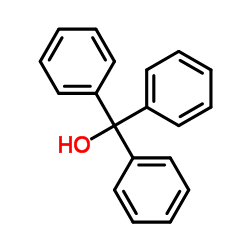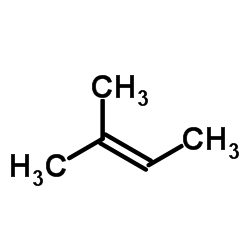593-74-8
| Name | dimethylmercury |
|---|---|
| Synonyms |
Dimethyl-quecksilber
MFCD00014845 Mercury,dimethyl DIMETHYLMERCURY methyl-Hg-methyl diemthylmercury dimethylmercure EINECS 209-805-3 dimethyl-mercury UNII-C60TQU15XY |
| Density | 2.961 g/mL at 25ºC(lit.) |
|---|---|
| Boiling Point | 93-94ºC(lit.) |
| Melting Point | -43ºC(lit.) |
| Molecular Formula | C2H6Hg |
| Molecular Weight | 230.65900 |
| Flash Point | 42ºC |
| Exact Mass | 232.01800 |
| LogP | 1.16510 |
| Index of Refraction | n20/D 1.543(lit.) |
| Storage condition | Flammables area |
| Stability | Stable. Highly flammable. Incompatible with strong oxidizing agents. |
| Water Solubility | insoluble H2O; soluble ether, alcohol [MER06] |
Synonym:None Section 2 - COMPOSITION, INFORMATION ON INGREDIENTS
Risk Phrases: 11 33 39/27 Section 3 - HAZARDS IDENTIFICATION EMERGENCY OVERVIEW
Highly flammable. Danger of cumulative effects. Very toxic : danger of very serious irreversible effects in contact with skin. Potential Health Effects Eye: Causes eye irritation. Skin: Causes skin irritation. May be fatal if absorbed through the skin. May cause skin sensitization, an allergic reaction, which becomes evident upon re-exposure to this material. If absorbed, causes symptoms similar to those of inhalation. Effects may be delayed. May cause severe dermatitis and burns. Ingestion: May cause irritation of the digestive tract. May cause effects similar to those for inhalation exposure. Inhalation: Inhalation of fumes may cause metal fume fever, which is characterized by flu-like symptoms with metallic taste, fever, chills, cough, weakness, chest pain, muscle pain and increased white blood cell count. Systemic intoxication is cumulative and has been fatal. May produce numbness and tingling of the lips, hands, and feet (paresthesia) and ataxia (failure of muscular coordination). Exposure may produce speech disturbances, constriction of the visual fields, hearing impairment, and emotional disturbances. Severe intoxication may produce clonic seizures, (which may be irreversible), incontinence, spasticity, jerking of the limbs, head, and shoulders. Severe intoxication may produce emotional disturbances, hypersalivation, tearing, nausea, vomiting, and diarrhea or constipation. Chronic: Prolonged or repeated skin contact may cause dermatitis. Chronic inhalation and ingestion may cause effects similar to those of acute inhalation and ingestion. May cause fetal effects. Chronic exposure to mercury may cause permanent central nervous system damage, fatigue, weight loss, tremors, personality changes. Chronic ingestion may cause accumulation of mercury in body tissues. Chronic exposure to mercury vapors may produce weakness, fatigue, anorexia, loss of weight and gastrointestinal disturbances which is collectively referred to as asthenic-vegetative syndrome or micromercurialism. Chronic exposure to mercury compounds may produce immunologic glomerular disease. Section 4 - FIRST AID MEASURES Eyes: Flush eyes with plenty of water for at least 15 minutes, occasionally lifting the upper and lower eyelids. Get medical aid immediately. Do NOT allow victim to rub eyes or keep eyes closed. Skin: Get medical aid immediately. Flush skin with plenty of water for at least 15 minutes while removing contaminated clothing and shoes. Wash clothing before reuse. Discard contaminated clothing in a manner which limits further exposure. SPEEDY ACTION IS CRITICAL! Ingestion: If victim is conscious and alert, give 2-4 cupfuls of milk or water. Never give anything by mouth to an unconscious person. Get medical aid immediately. Inhalation: Get medical aid immediately. Remove from exposure and move to fresh air immediately. If not breathing, give artificial respiration. If breathing is difficult, give oxygen. Notes to Physician: Section 5 - FIRE FIGHTING MEASURES General Information: As in any fire, wear a self-contained breathing apparatus in pressure-demand, MSHA/NIOSH (approved or equivalent), and full protective gear. Vapors may form an explosive mixture with air. During a fire, irritating and highly toxic gases may be generated by thermal decomposition or combustion. Use water spray to keep fire-exposed containers cool. Containers may explode in the heat of a fire. Flammable liquid and vapor. Vapors may be heavier than air. They can spread along the ground and collect in low or confined areas. Containers may explode when heated. Extinguishing Media: For small fires, use dry chemical, carbon dioxide, water spray or alcohol-resistant foam. For large fires, use water spray, fog, or alcohol-resistant foam. Use water spray to cool fire-exposed containers. Water may be ineffective. Do NOT use straight streams of water. Section 6 - ACCIDENTAL RELEASE MEASURES General Information: Use proper personal protective equipment as indicated in Section 8. Spills/Leaks: Absorb spill with inert material (e.g. vermiculite, sand or earth), then place in suitable container. Remove all sources of ignition. Provide ventilation. A vapor suppressing foam may be used to reduce vapors. Water spray may reduce vapor but may not prevent ignition in closed spaces. Section 7 - HANDLING and STORAGE Handling: Wash thoroughly after handling. Ground and bond containers when transferring material. Use spark-proof tools and explosion proof equipment. Do not get in eyes, on skin, or on clothing. Empty containers retain product residue, (liquid and/or vapor), and can be dangerous. Keep container tightly closed. Keep away from heat, sparks and flame. Do not ingest or inhale. Use only in a chemical fume hood. Do not pressurize, cut, weld, braze, solder, drill, grind, or expose empty containers to heat, sparks or open flames. Storage: Keep away from heat, sparks, and flame. Keep away from sources of ignition. Store in a tightly closed container. Store in a cool, dry, well-ventilated area away from incompatible substances. Section 8 - EXPOSURE CONTROLS, PERSONAL PROTECTION Engineering Controls: Use only under a chemical fume hood. Exposure Limits CAS# 593-74-8: United States OSHA: 0.4 mg/m3 Ceiling (listed under Mercury, alk compounds). Belgium - TWA: (listed as mercury, alkyl compounds): 0.01 mg/m3 V (as Hg) Belgium - STEL: (listed as mercury, alkyl compounds): 0.03 mg/m3 (as Hg) France - VME: (listed as mercury, alkyl compounds): 0.01 mg/m3 VM (as Hg) Germany: (listed as mercury, alkyl compounds): 0.01 mg/m3 VME (as Malaysia: (listed as mercury, alkyl compounds): 0.01 mg/m3 TWA (a Hg) Netherlands: (listed as mercury, alkyl compounds): 0.02 mg/m3 STE (as Hg) Netherlands: (listed as mercury, alkyl compounds): 0.01 mg/m3 MAC Hg) Spain: (listed as mercury, alkyl compounds): 0.01 mg/m3 VLA-ED (a Hg) Spain: (listed as mercury, alkyl compounds): 0.03 mg/m3 VLA-EC (a Hg) Personal Protective Equipment Eyes: Wear chemical splash goggles. Wear appropriate protective eyeglasses or chemical safety goggles as described by OSHA's eye and face protection regulations in 29 CFR 1910.133 or European Standard EN166. Skin: Wear plastic-laminate glove (SilverShield) alone or in combination with other gloves. Clothing: Wear appropriate protective clothing to prevent skin exposure. Wear an impervious apron. Respirators: Follow the OSHA respirator regulations found in 29 CFR 1910.134 or European Standard EN 149. Use a NIOSH/MSHA or European Standard EN 149 approved respirator if exposure limits are exceeded or if irritation or other symptoms are experienced. Section 9 - PHYSICAL AND CHEMICAL PROPERTIES Physical State: Liquid Color: colorless Odor: faint sweet odor pH: Not available. Vapor Pressure: Not available. Viscosity: Not available. Boiling Point: 93 - 94 deg C Freezing/Melting Point: -43 deg C Autoignition Temperature: Not available. Flash Point: 5 deg C ( 41.00 deg F) Explosion Limits, lower: Not available. Explosion Limits, upper: N/A Decomposition Temperature: Solubility in water: Specific Gravity/Density: 2.9610g/cm3 Molecular Formula: C2H6Hg Molecular Weight: 230.67 Section 10 - STABILITY AND REACTIVITY Chemical Stability: Stable at room temperature in closed containers under normal storage and handling conditions. Conditions to Avoid: Incompatible materials, ignition sources, excess heat. Incompatibilities with Other Materials: Strong oxidizing agents. Hazardous Decomposition Products: Carbon monoxide, irritating and toxic fumes and gases, carbon dioxide, toxic fumes of mercury. Hazardous Polymerization: Has not been reported Section 11 - TOXICOLOGICAL INFORMATION RTECS#: CAS# 593-74-8: OW3010000 LD50/LC50: Not available. Carcinogenicity: Dimethylmercury - Not listed by ACGIH, IARC, or NTP. Other: See actual entry in RTECS for complete information. Section 12 - ECOLOGICAL INFORMATION Section 13 - DISPOSAL CONSIDERATIONS Dispose of in a manner consistent with federal, state, and local regulations. Section 14 - TRANSPORT INFORMATION IATA Shipping Name: FLAMMABLE LIQUID, TOXIC, N.O.S.* Hazard Class: 3 (6.1) UN Number: 1992 Packing Group: I IMO Shipping Name: FLAMMABLE LIQUID, TOXIC, N.O.S. Hazard Class: 3.2 (6.1) UN Number: 1992 Packing Group: I RID/ADR Shipping Name: FLAMMABLE LIQUID, TOXIC, N.O.S. Hazard Class: 3 (6.1) UN Number: 1992 Packing group: I Section 15 - REGULATORY INFORMATION European/International Regulations European Labeling in Accordance with EC Directives Hazard Symbols: T+ F Risk Phrases: R 11 Highly flammable. R 33 Danger of cumulative effects. R 39/27 Very toxic : danger of very serious irreversible effects in contact with skin. Safety Phrases: S 9 Keep container in a well-ventilated place. S 13 Keep away from food, drink and animal feeding stuffs. S 16 Keep away from sources of ignition - No smoking. S 28A After contact with skin, wash immediately with plenty of water. S 33 Take precautionary measures against static discharges. S 36 Wear suitable protective clothing. S 45 In case of accident or if you feel unwell, seek medical advice immediately (show the label where possible). WGK (Water Danger/Protection) CAS# 593-74-8: No information available. Canada CAS# 593-74-8 is listed on Canada's NDSL List. CAS# 593-74-8 is listed on Canada's Ingredient Disclosure List. US FEDERAL TSCA CAS# 593-74-8 is listed on the TSCA inventory. SECTION 16 - ADDITIONAL INFORMATION N/A |
CHEMICAL IDENTIFICATION
HEALTH HAZARD DATAACUTE TOXICITY DATAMUTATION DATA
|
| Hazard Codes | T+,N |
|---|---|
| Risk Phrases | R26/27/28 |
| Safety Phrases | S26-S36 |
| RIDADR | UN 3383 |
| WGK Germany | 3 |
| RTECS | OW3010000 |
| Packaging Group | II |
| Hazard Class | 3.1 |
| Precursor 10 | |
|---|---|
| DownStream 9 | |







![Bis[trifluoromethyl]mercury structure](https://image.chemsrc.com/caspic/260/371-76-6.png)











